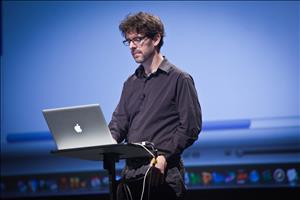On October 23, 2013, Stephen Vitiello (b. 1964) receives a $200,000 commission to create a permanent sound-art installation as part of the arts component of a planned major redevelopment of the Seattle waterfront. A Richmond, Virginia-based artist and associate professor of kinetic imaging at Virginia Commonwealth University, Vitiello has been curating, creating, and collaborating with visual artists and musicians on sound-art projects since the late 1980s. He is one of 16 artists invited to participate in "Soundings: A Modern Score," the Museum of Modern Art's first major sound-art exhibition.
Four other artists -- Ann Hamilton (b. 1956), Oscar Tuazon (b. 1975), Buster Simpson (b. 1942), and Norie Sato (b. 1949) -- were also commissioned in 2013 and 2014 to create art on Seattle's waterfront. The art commissions were just one component of a much larger redevelopment project to rebuild Seattle's badly deteriorated seawall, replace the Alaskan Way Viaduct with an underground tunnel, and create "vibrant new public space" ("About the Program") in the new connection between the waterfront and Pike Place Market.
Electronic Arts Intermix
Stephen Vitiello's path to receiving the commission for a sound-art installation on the Seattle waterfront followed a circuitous route that started in New York City at Electronic Arts Intermix (EAI), a nonprofit dedicated to preserving and exhibiting media art. That's where Vitiello met renowned video-art pioneer Nam June Paik in 1991 and started tinkering with translating visual elements into audio recordings. Vitiello said, "I didn't really become an interesting musician until I started working with visual artists and started looking for ways to parallel the ways artists were processing images" (Goldsmith).
Kenneth Goldsmith, writing for New Music Box, elaborated, "For instance, while working with filmmaker Jem Cohen in the early 90s, Vitiello noticed the kind of time lapses he was incorporating into his films -- using delays to mirror time lapses -- and began to use the same sorts of devices in his music" (Goldsmith).
Listening to Structures
Vitiello continued to experiment through the 1990s and, in 1999, became an artist-in-residence on the 91st floor of the World Trade Center. He had planned on opening the windows and recording the sounds outside, but he discovered that the windows on the 91st floor didn't actually open. Vitiello instead attached contact microphones to the windows and recorded the building's own creaking and crackling along with sounds from outside.
Vitiello also experimented with light, pointing photocells through a telescope at the red and blue lighting of police cars and the white lights of neighboring office towers. Once hooked up to audio cables, the photocells translated tones of light into tones of sound.
The project was an exercise in recording the essence of a place through listening to its subtle movements, its between-sounds, and its non-sounds. When planners of the new High Line Park in New York wanted an aural representation of the city, they commissioned Vitiello.
From High Line to Water Line
The High Line was an elevated rail line that was built in the 1930s, but stopped carrying train traffic in the 1980s. Rather than demolishing the industrial structure, the city repurposed it. The project ultimately converted the 22 blocks of unused rail into a public park with restaurants and art programming.
The lead design firm for the Seattle waterfront project, James Corner Field Operations, also designed the High Line, where Vitiello installed A Bell for Every Minute from June 2010 through June 2011.
He recorded 100 bells throughout New York and ultimately used 59 of the recorded bells. For the piece, which was installed in a semi-enclosed tunnel, one bell rang every minute with all 59 bells ringing together on the hour. Vitiello intentionally minimized visual interference in the exhibition space by painting the walls, chairs, ceiling, and floor the same shade of gray. The only visual accompanying the sound was a map of the sites where he had made the recordings, with "just enough of a visual interface" ("Lecture by ...") to give people an idea of what they were hearing.
Like the High Line, Seattle's waterfront redevelopment also involved the adaptive remaking of obsolete industrial infrastructure into a space for the public to wander, eat, and encounter art.
In a 2014 interview with The Stranger's Jen Graves, Vitiello discussed some potential ways of recording Seattle:
"For Seattle, Vitiello considered somehow inverting the legendary, record-breaking noise that roars out of CenturyLink Field when the Seahawks play. But it might become dated, he figured. He hasn't yet found any local sound 'true enough' to become a field recording capable of playing at the waterfront for the next 30 years, so he's considering acoustic options, maybe something played by the elements" (Graves).

